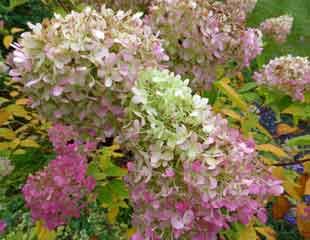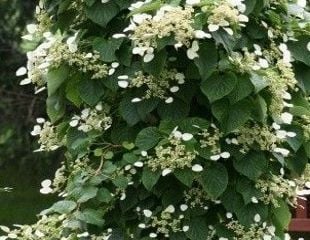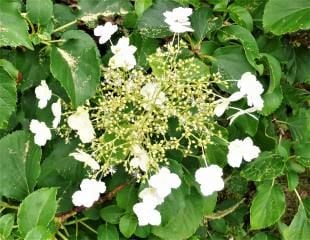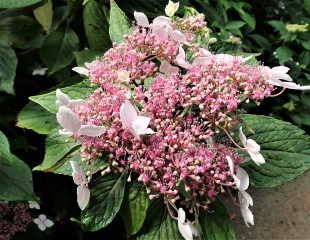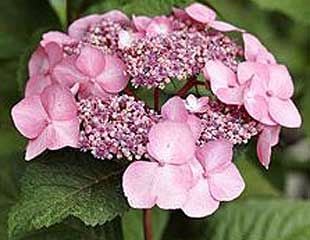
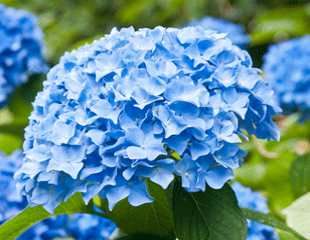
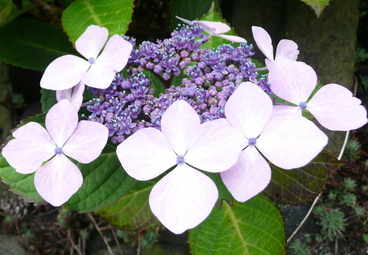
How to Grow Hydrangeas
Hydrangea are a deciduous, summer flowering shrub with large, showy flowers.
Hydrangea are easy to grow and require only minimal pruning. They are not fussy about soil types and most, including the climbing Hydrangea, will grow in partial shade. Most hydrangeas are large shrubs from 1.5m - 3m (3-10ft) requiring a fair amount of growing space.
Hydrangea predominately flower in shades of pink, mauve, blue, cream and white, and multicoloured such as Hydrangea macrophylla 'Merveille'. Some varieties of hydrangea change colour depending on the pH of the soil, acid or alkaline. This applies to H. macrophylla, the mopheads and lacecaps varieties, where the flowers are blue when grown in an acid soil and pink if planted in alkaline soil; the white flowers are unaffected.
There are also some varieties of Hydrangea which have scented blooms, such as Hydrangea paniculata 'Wim's Red' and also some compact varieties H. panciulata Little lime ('Jane') and Hydrangea with beautiful delicate colours such as pink turning to white as in Hydrangea paniculata Vanille Fraise ('Renhy')
Hydrangeas have a wide and varied range, and many are illustrated below and on a Pinterest board. When selecting a Hydrangea for the garden check out the variety carefully, some will grow to around 3m which is a bit large for the average garden , but there are Macrophylla varieties which reach around 1.5m. a useful size for most gardens.
How to Plant Hydrangea
Hydrangea are a woodland plant with a preference for moist but well-drained soil with some sun and dappled shade. As a woodland plant, Hydrangea will thrive in the cooler part of the garden and is best planted away from the hot afternoon sun. As always, it is a question of the right plant right place, which means avoid planting where there is hot afternoon sun or cold easterly winds.
Hydrangeas are not drought tolerant, quite the reverse Hydrangea is a moisture loving shrub. With changes in our climate, these considerations become more significant.
There is a climbing form of Hydrangea, H. petiorlaris, which will tolerate a higher degree of shade. This variety of Hydrangea is suitable to grow up a shady or North/North-east wall. It is a lovely climber, relatively fast growing, with beautiful white flowers in the spring. I have seen grown to great effect on a large semi shaded wall. It was left to grow unchecked and formed a mass of white flowers in the spring. The climbing hydrangea is self-supporting but vigorous, needing a reasonably large space.
Having decided where to plant your Hydrangea, dig a hole at least 3 times the size of the root ball and deep enough so the level of the compost in its container is at soil level. Do not plant Hydrangea too deep, keep the level the same and water the hole well before planting. Hydrangea do not thrive on dry soil and will benefit from a mulch to retain moisture. Make sure the shrub is firm and well watered.
Hydrangea are long flowering
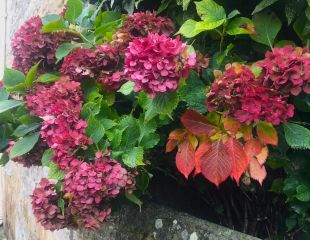
One of the big plus points in growing hydrangea is they are long flowering, usually for several weeks. In addition, Hydrangea belong to that special group of plants whose flowers look good as they fade.
Add into this group Achillea, lavender, Agapanthus, Thalictrum, and Sedum, all good value plants.
I took this image of the Hydrangea on the 22nd October and it is still looking good. Clearly, it has been flowering a long time and the colours changes as the flowers age. Hydrangea make great cut flowers at all stages of the flowering cycle.
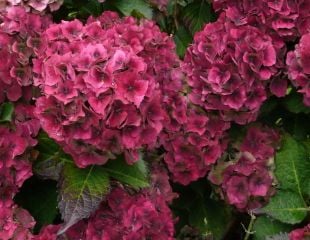
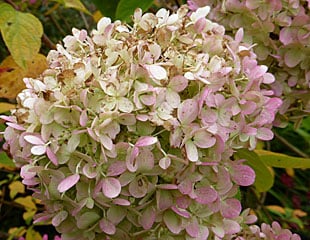
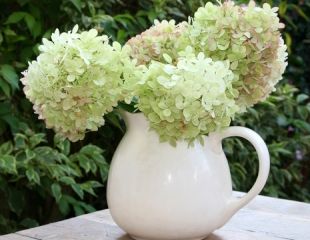
Growing Hydrangea in containers
I recommend growing hydrangeas in the border as they are not ideal for growing in containers. In part, this is because they can get large, and their roots quickly expand into the container. In addition, Hydrangea thrive in damper conditions and soil in containers is prone to drying out. All plants grown in containers are at risk of drying out because of the relatively small growing area.
Whilst many Hydrangeas get large, up to 2.5m + new varieties are being developed all the time and there are now many smaller patio varieties are potentially more suitable for growing in a container, such as: Hydrangea macrophylla 'Little Purple'; Hydrangea macrophylla Magical Green Delight; Hydrangea arborescens 'Candybelle Bubblegum'. Many are illustrated and offered for sale Crocus affiliate link to Hydrangeas for containers.
If you are interested in seeing all types of Hydrangeas the national collection is maintained at Darely Park in Derby with over 900 varieties on display and its free to visit. There are also lots of Hydrangeas in a natural woodland valley in Bodnant Garden in Conway, Wales.
Four of the most common types of Hydrangea
Hydrangea Paniculata
This is Hydrangea Paniculata which is a large variety growing up to 7 x 5m. It flowers best if regularly pruned in the spring, see below. It flowers in the late summer, producing white or cream flowers.
As its name suggests, the flowers are cone shaped and appear in late summer early autumn changing colour as they fade.
Hydrangea Petiolaris
This is the climbing form of Hydrangea variety growing up to 15m. It will easily cover a wall. It rewards with fantastic fresh green foliage in spring, and lovely delicate flowers in early summer.
It is spring flowering, and should be pruned after it has flowered. A vigorous, deciduous climber which is fully hardy, self clinging and shade tolerant.
Hydrangea macrophylla
This group includes both Mopheads and Lacecaps, which are the most commonly grown and have large showy blooms.
Mopheads have rounded flower heads and Lacecaps flattened flower heads.
In this group of hydrangeas, the soil type determines the flower color. Blue blooms on acid soil and Pink on alkaline.
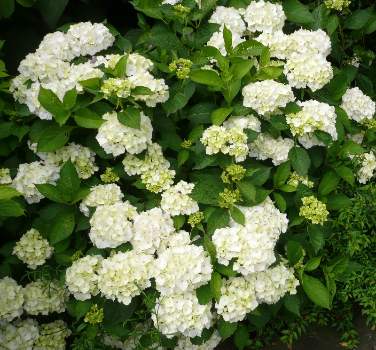
Hydrangea arborescens
A rounded shaped shrub which has large flowers, white, which appear in the summer.
Illustrated is H. arborescens 'Annabelle' which has large flowers around 20cms across. It has multiple blooms which turn from white green to pure white.
When and How to Prune Hydrangea
You need to decide which type of Hydrangea you have to know how and when to prune it. Hopefully, the images and descriptions above may help.
H. Mophead and Lacecaps flower on old wood (what does this mean?) prune lightly in spring. Just cut back a few cm down to a bud. Do not prune hard, although you can remove spindly, weak growth. The image drawing below shows the light prune required for Mopheads and Lacecaps.
Hydrangea paniculata, distinguishable by its cone shaped blooms, flowers on the current year's growth (wood) and it is pruned harder in late winter/early spring. This means all the flowers are produced on new stems which grow in the same year as flowering. When you prune H. paniculata, cut back to a framework to enable the shrub to make new growth.
Pruning is not essential both Mophead and Lacecap will flower without pruning. The benefit of pruning is to keep the shrub in shape and pruning can improve flowering.
Pruning in late winter or early spring has the risk of frost. If there is a severe frost, it can damage the new growth, and it may be necessary to prune again back further to a pair of healthy buds. Also on older shrubs remove a few, 2/3 older stems from the based which will encourage new growth later in the spring.
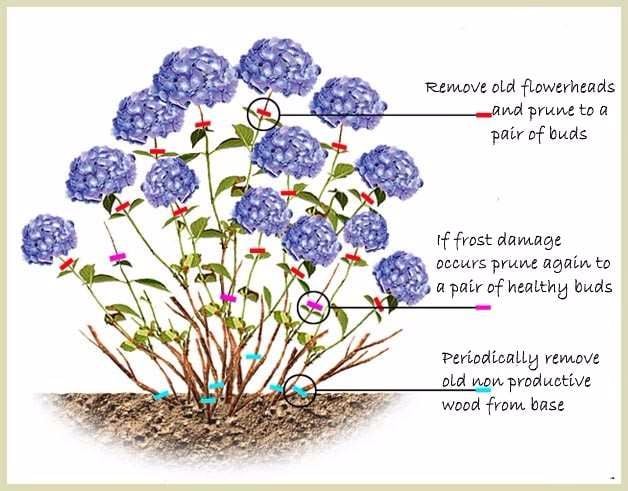
1. Lacecap Hydrangea just light prune in February to remove the top of the stems with last season's flower head in place. Cut down to just above a green bud, which should be evident by late winter around February. Do not prune harder, or lower, a mistake which can prevent the Hydrangea flowering later in the summer.
2.Climbing Hydrangea prune immediately after flowering to restrict its growth, cutting back long shoots. If pruning hard, it is best to stagger over more than one year because if it is pruned hard all at once, there may be significantly fewer flowers the next year.
3 Hydrangea paniculata and H. arborescens need more attentive pruning, (which may be why they are less popular.) Each spring prune back to a framework which means cutting back stems to a pair of buds. These varieties flower best if pruned harder. This means you can cut back to the lowest pair of buds, which may result in the plant, post pruning, only being 25cms but you can, of course, leave several buds on and prune less hard.
The easiest hydrangea to grow are the Lacecaps and Mopheads, as you can simply remove the old flower heads in the spring, cutting down to a pair of buds and that's it.

Hydrangea is a green wheelbarrow shrub, being easy to grow and tolerant of most conditions.


